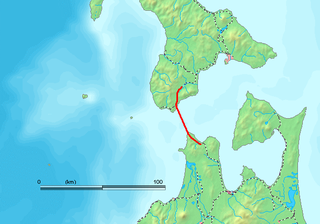 W
WThe Seikan Tunnel, is a 53.85 km (33.46 mi) dual gauge railway tunnel in Japan, with a 23.3 km (14.5 mi) long portion under the seabed of the Tsugaru Strait, which separates Aomori Prefecture on the main Japanese island of Honshu from the northern island of Hokkaido. The track level is about 100 m (330 ft) below the seabed and 240 m (790 ft) below sea level. The tunnel is part of the standard gauge Hokkaido Shinkansen and the narrow gauge Kaikyō Line of the Hokkaido Railway Company 's Tsugaru-Kaikyō Line. The name Seikan comes from combining the on'yomi readings of the first characters of Aomori (青森), the nearest major city on the Honshu side of the strait, and Hakodate (函館), the nearest major city on the Hokkaido side.
 W
WThe Hokkaido Shinkansen is a Japanese high-speed Shinkansen rail line that links up with the Tōhoku Shinkansen in northern Aomori Prefecture in Honshu and continues on into the interior of Hokkaido through the undersea Seikan Tunnel. Construction started in May 2005; the initial Shin-Aomori to Shin-Hakodate-Hokuto section opened on 26 March 2016. Extension of the line to Sapporo is scheduled to open by fiscal year 2030. The line is operated by the Hokkaido Railway Company.
 W
WThe Kaikyō Line is an 87.8-kilometer long railway line operated mainly by the Hokkaido Railway Company. The line connects Naka-Oguni Station in Sotogahama, Aomori, through the Seikan Tunnel between Honshu and Hokkaido, to Kikonai Station in Kikonai, Hokkaido. Two stations on the Tsugaru-Kaikyō Line, Tappi-Kaitei Station and Yoshioka-Kaitei Station, were inside the tunnel.
 W
WTappi-Kaitei Station was a railway station on the Kaikyo Line in Sotogahama, Aomori, Japan, operated by Hokkaido Railway Company. The station is located within the Seikan Tunnel below the seabed of the Tsugaru Strait linking the main Japanese island of Honshu with the northern island of Hokkaido. It was closed to passengers from November 10, 2013, to make way for the construction of the Hokkaido Shinkansen high-speed train line. It is an emergency escape point.
 W
WTōya Maru (洞爺丸) was a Japanese train ferry constructed by Japanese National Railways (JNR) which sank during a typhoon, later known locally as the Tōya Maru Typhoon, in the Tsugaru Strait between the Japanese islands of Hokkaidō and Honshū on September 26, 1954. JNR announced in September 1955 that 1,153 people aboard were killed in the accident. However, the exact number of fatalities remains unknown because there were victims who managed to obtain passage on the ship at the last minute, and others who cancelled their tickets just before the incident occurred.
 W
W"Train on Train" is a concept for piggybacking by the trainload rather than one wagon at a time.
 W
WYoshioka-Kaitei Station was a railway station on the Kaikyo Line in Fukushima, Hokkaido, Japan, operated by Hokkaido Railway Company. The station was underground and was located within the Seikan Tunnel under the Tsugaru Strait linking the main Japanese island of Honshu with the northern island of Hokkaido. The station was located 149.5 metres (490 ft) below sea level, making it the deepest underground station in the world.